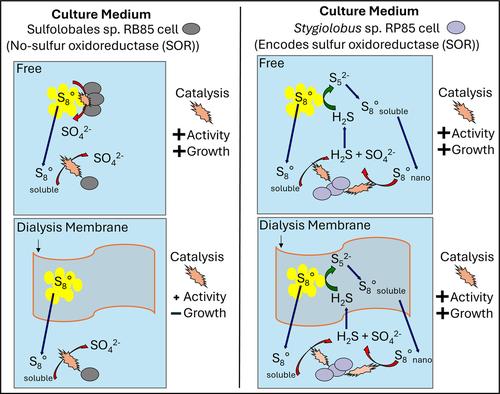当前位置:
X-MOL 学术
›
Environ. Microbiol.
›
论文详情
Our official English website, www.x-mol.net, welcomes your
feedback! (Note: you will need to create a separate account there.)
Acquisition of elemental sulfur by sulfur‐oxidising Sulfolobales
Environmental Microbiology ( IF 4.3 ) Pub Date : 2024-08-29 , DOI: 10.1111/1462-2920.16691 Maria C Fernandes-Martins 1 , Carli Springer 1 , Daniel R Colman 1 , Eric S Boyd 1
Environmental Microbiology ( IF 4.3 ) Pub Date : 2024-08-29 , DOI: 10.1111/1462-2920.16691 Maria C Fernandes-Martins 1 , Carli Springer 1 , Daniel R Colman 1 , Eric S Boyd 1
Affiliation

|
Elemental sulfur (S8 0 )‐oxidising Sulfolobales (Archaea) dominate high‐temperature acidic hot springs (>80°C, pH <4). However, genomic analyses of S8 0 ‐oxidising members of the Sulfolobales reveal a patchy distribution of genes encoding sulfur oxygenase reductase (SOR), an S8 0 disproportionating enzyme attributed to S8 0 oxidation. Here, we report the S8 0 ‐dependent growth of two Sulfolobales strains previously isolated from acidic hot springs in Yellowstone National Park, one of which associated with bulk S8 0 during growth and one that did not. The genomes of each strain encoded different sulfur metabolism enzymes, with only one encoding SOR. Dialysis membrane experiments showed that direct contact is not required for S8 0 oxidation in the SOR‐encoding strain. This is attributed to the generation of hydrogen sulfide (H2 S) from S8 0 disproportionation that can diffuse out of the cell to solubilise bulk S8 0 to form soluble polysulfides (Sx 2− ) and/or S8 0 nanoparticles that readily diffuse across dialysis membranes. The Sulfolobales strain lacking SOR required direct contact to oxidise S8 0 , which could be overcome by the addition of H2 S. High concentrations of S8 0 inhibited the growth of both strains. These results implicate alternative strategies to acquire and metabolise sulfur in Sulfolobales and have implications for their distribution and ecology in their hot spring habitats.
中文翻译:

通过硫氧化硫叶菌获得元素硫
元素硫 (S80) 氧化性硫化叶菌(古细菌)在高温酸性温泉中占主导地位(>80°C,pH <4)。然而,对硫化叶菌目 S80 氧化成员的基因组分析揭示了编码硫加氧酶还原酶 (SOR) 的基因的不均匀分布,SOR 是一种归因于 S80 氧化的 S80 歧化酶。在这里,我们报告了先前从黄石国家公园酸性温泉中分离出的两种硫化叶菌菌株的 S80 依赖性生长,其中一种在生长过程中与大量 S80 相关,另一种则不然。每个菌株的基因组编码不同的硫代谢酶,其中只有一种编码SOR。透析膜实验表明,SOR 编码菌株中的 S80 氧化不需要直接接触。这是由于 S80 歧化产生硫化氢 (H2S),硫化氢 (H2S) 可以扩散到细胞外,溶解大量 S80,形成可溶性多硫化物 (Sx2−) 和/或 S80 纳米颗粒,很容易扩散穿过透析膜。缺乏 SOR 的硫化叶菌菌株需要直接接触才能氧化 S80,这可以通过添加 H2S 来克服。高浓度的S80抑制两种菌株的生长。这些结果暗示了硫叶藻获取和代谢硫的替代策略,并对其在温泉栖息地的分布和生态产生影响。
更新日期:2024-08-29
中文翻译:

通过硫氧化硫叶菌获得元素硫
元素硫 (S80) 氧化性硫化叶菌(古细菌)在高温酸性温泉中占主导地位(>80°C,pH <4)。然而,对硫化叶菌目 S80 氧化成员的基因组分析揭示了编码硫加氧酶还原酶 (SOR) 的基因的不均匀分布,SOR 是一种归因于 S80 氧化的 S80 歧化酶。在这里,我们报告了先前从黄石国家公园酸性温泉中分离出的两种硫化叶菌菌株的 S80 依赖性生长,其中一种在生长过程中与大量 S80 相关,另一种则不然。每个菌株的基因组编码不同的硫代谢酶,其中只有一种编码SOR。透析膜实验表明,SOR 编码菌株中的 S80 氧化不需要直接接触。这是由于 S80 歧化产生硫化氢 (H2S),硫化氢 (H2S) 可以扩散到细胞外,溶解大量 S80,形成可溶性多硫化物 (Sx2−) 和/或 S80 纳米颗粒,很容易扩散穿过透析膜。缺乏 SOR 的硫化叶菌菌株需要直接接触才能氧化 S80,这可以通过添加 H2S 来克服。高浓度的S80抑制两种菌株的生长。这些结果暗示了硫叶藻获取和代谢硫的替代策略,并对其在温泉栖息地的分布和生态产生影响。


















































 京公网安备 11010802027423号
京公网安备 11010802027423号